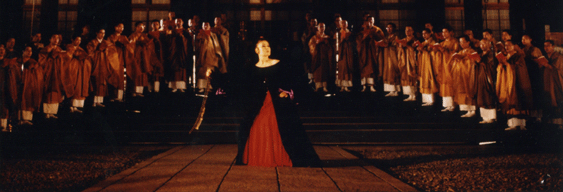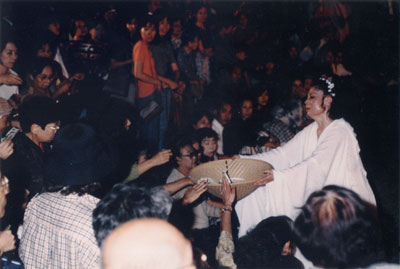A Pilgrimage of Mendicancy by the Buddhist Monks.
(Takuhatsu Angya no Tabi)

This performance is based on Mandala,, depicting human's original sin and its salvation with a spectacular chanting of 50 Buddhist monks, staged in 1983 at the Carnegie Hall, N.Y. with a great sensation.Б@
Later, Mandala was performed in 13 places in Japan in the form of an open-air stage as a pilgrimage of mendicancy with a score of Buddhist monks.
Nine years ago, I made a pilgrimage of mendicancy with scores of Buddhist monks visiting 13 places of Japan. In each place, as I started to dance with the strong and resonant chanting of the monks, I felt the audience and performers are combined in a sense of unity and their compassion seemed to have pierced through earth and soared up to heaven-an unforgettable experience for me. I sensed the existence of the cosmos there and felt the happiness of being a dancer. I now feel it is my dream and duly to continue this activity.
I am very happy to announce that I'll be able to make a pilgrimage of mendicancy in Europe with a warm cooperation of the Buddhist monks of Japan. I sincerely hope that we can share the joy of mutual compassion with as many people as possible there. Takuhatsu is a pilgrimage of the Buddhist monks who visit people to recite a sutra for their happiness and, in return, receive food from them. Our performance will last about an hour, depicting a woman who dances a journey of revelation-from "carnal desires" to "spiritual salvation". It expresses the beauty and strength of life.

БЬHere's an evil woman (in the form of the sin that lurks the humanity).
She is in hiding in the mountain bushes, waiting for the travelers walking
on the field path, robbing them of their belongings. She's been committing
this act repeatedly day and night.
БЬ Chanting of sutras is rising (as a voice guiding her away from her
sinful ways).
Hearing the sutras, the woman feels as if her layers of sin are coming
off one by one. She begins to feel the Buddha's spirit in herself as if
she were spiritually awakened. But this doesn't last long. She is consumed
by burning evil desires again. While entirely buried in evil passions,
she's also frightened to hear the ever intensifying chanting of sutras.
БЬ The river of hesitation (as a symbol of mind hovering between evil
passions and spiritual salvation)
The woman is wandering. Torn between the howling of evil desires and spiritual
awakening, she continues the journey of delusion.
Finally, she is cleansed and find herself beautiful.
БЬ Bosatsu, or Bodhisattva (as the form of Buddhist saint who has acquired
a spiritual enlightenment)
The woman, delivered from earthly bondage, has become Bosatsu.
The beautiful visage of Bosatsu.
Bosatsu looks up to the heaven and casts benevolent eyes to all things
under the sun.

It clicks, when an image cannot be seen.
Buddhism was introduced to Japan in the sixth century through China.
Soon, it spread widely due to the efforts of Prince Shotoku (Shotoku Taishi573-622),
a charismatic regent to the emperor, who esteemed its teachings highly.
It is said that Japan's Buddhism has now 13 major sects with 56 smaller
divisions. Among them the Buzan division belonging to the Shingon sect
is said to have the most musically excellent chanting and the monks participating
this tour are from the Buzan temples that are scattered all over the country.
| БЬThe schedule of "MANDALA" | |||
|